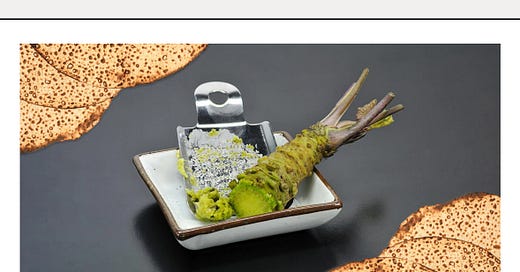Two nights ago, at our Passover Seder meal, my son wept. The tears kept coming. He tried to chug anything in sight, including his sister’s glass of grape juice. Poor guy used too much in a moment of bravado. It all points to wasabi…
At our Seder Table, like Jews all over the world, we retell the story of the Exodus—when the Israelites were slaves in Egypt, and we continue into their dramatic freedom—but in my home, we love to incorporate a little plant we call wasabi. Maybe you also use it, too, or maybe you use its cousin, horseradish. There is a spot for either on every labeled Seder Plate.
I write about our Jewish-Japanese experience in the form of this plant on The Nosher! I just love how my world, or worlds, connect during Passover—the Jewish and the Japanese. Check it out and tell me—have you experienced a Seder? Maybe you are a pro and you also host your own! Also, I am excited to hear what spicy, tear-inducing root you use! —-(PS Our son was A-OKAY).
I include wasabi to not sink down in bitter tears, but consciously embrace where I am and the life I continue to make and choose. I look at my children, at their precious identities, palettes, humor – their full heritage.
Every parent wants to affirm their child’s identity. Fusion is not a gimmick if there is meaning and personal context. Then it is seamless.
“It’s this plant before it’s the plastic packet in the sushi section of your Trader Joe’s or Prager’s,” I write.
For more about how to grate fresh wasabi, I recommend that you look to Washoku/Japanese cuisine master, teacher, and prolific author, Elizabeth Andoh! Here is a short and very complete primer on two ways that we grate in a Japanese kitchen. (And yes, shark shin graters for wasabi are (still) very much utilized). Click here to read and see why—
You’ll probably also want to subscribe to Elizabeth Andoh’s Kitchen Culture newsletter. Go for it.





